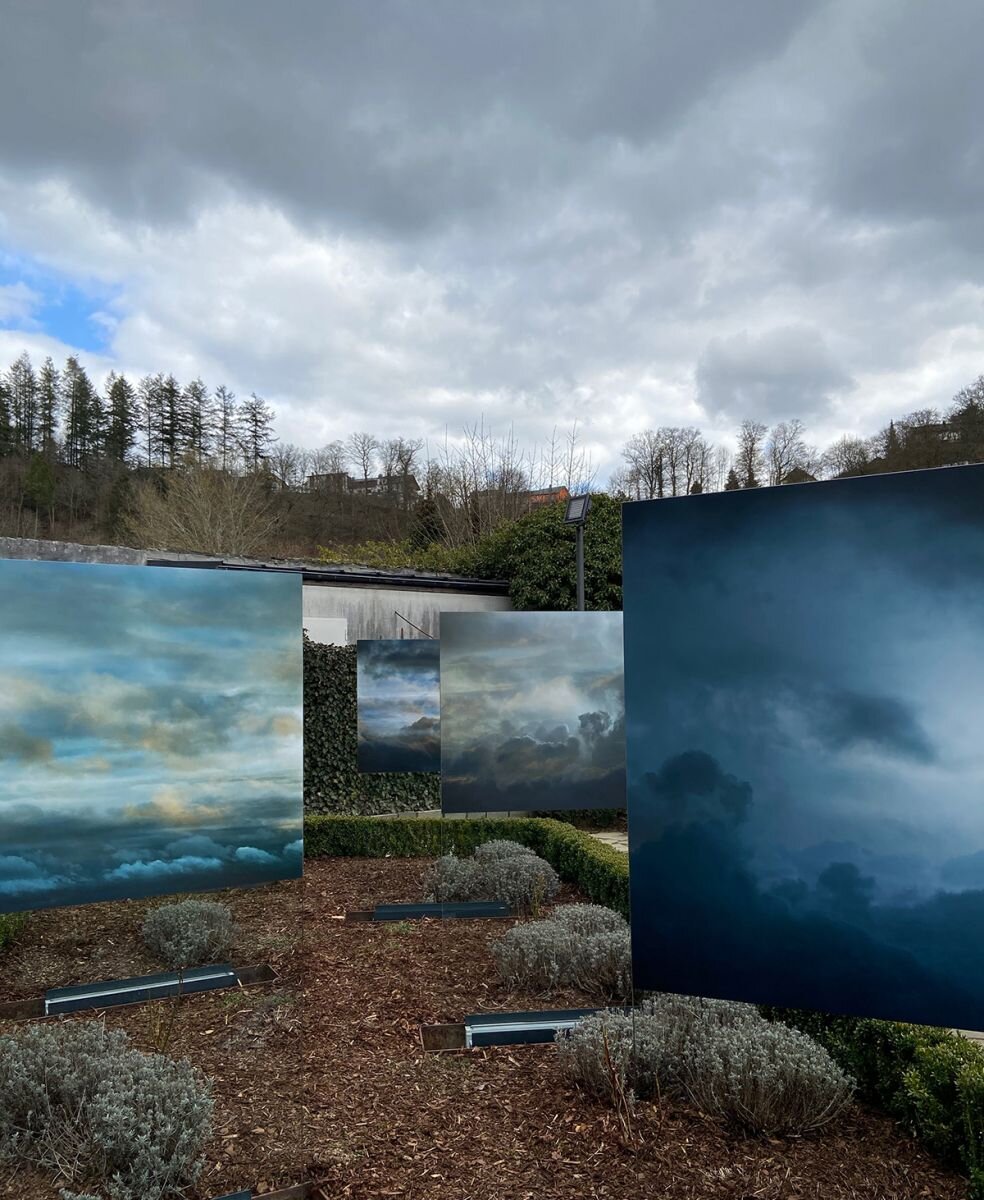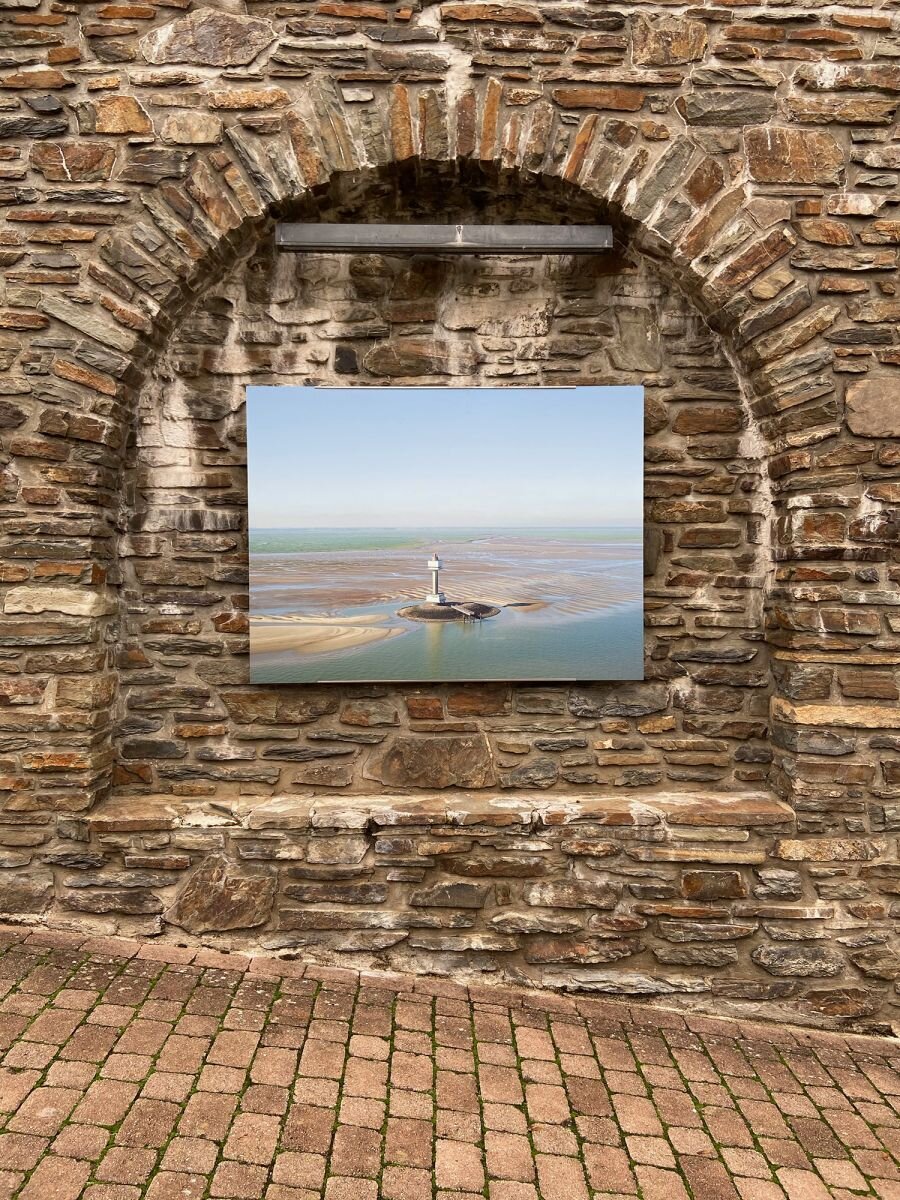
Dancing with my Camera - Dayanita Singh | Mudam Luxembourg
Mudam Luxembourg
12. Mai - 10. September 2023
Die Ausstellung findet im Rahmen des Europäischen Monats der Fotografie Luxemburg statt.
Dancing with my Camera
Dayanita Singh
Dayanita Singh, Mona Montage, 2021 © Dayanita Singh
Dayanita Singh (1961, Neu-Delhi) entwickelt seit vier Jahrzehnten ein genreübergreifendes Werk, in dem sie die Grenzen des Mediums Fotografie auslotet. Dancing with my Camera ist die umfangreichste Ausstellung, die der indischen Künstlerin bisher gewidmet wurde. Sie lässt ihr gesamtes Werk Revue passieren, von ihrem ersten Fotoprojekt über die Klangwelt des indischen Perkussionisten Zakir Hussain (1951, Bombay) bis hin zu jüngeren Arbeiten wie Let’s See (2021), die auf der Form des Foto-Kontaktbogens beruht. Die Ausstellung zeugt vom formalen Erfindungsreichtum, die Singhs Arbeit auszeichnet, und spiegelt ihre singuläre Sichtweise auf Themen wie Archive, Musik, Tanz, Architektur, Tod, Geschlecht oder Freundschaft.
Sing begreift Fotografie keineswegs als unbewegliches Bild, sondern als „Materie“ – als Ausgangspunkt, der dem „Wo“ und „Wann“ der Aufnahme weniger Bedeutung zumisst als dem Eindruck, den sie im Zusammenspiel mit anderen Bildern in der Erfahrung des Betrachters im Hier und Jetzt hinterlässt. Anhand eines einzigartigen Editingprozesses, bei dem der Intuition eine große Bedeutung zukommt, wählt die Künstlerin Bilder aus ihren Archiven aus, die sie anschließend miteinander verbindet, kombiniert und neu interpretiert. Dabei entstehen mobile Assemblagen in denen sie unterschiedliche Epochen, Orte, Personen, Architekturen, Motive und Objekte ineinanderfließen lässt. Singh ist vor allem bekannt für ihre Künstlerbücher, die einen wesentlichen Teil ihres Schaffens ausmachen und sich als eigenständige Ausstellungsräume verstehen. In ihnen experimentiert die Künstlerin mit unterschiedlichen fotografischen Präsentationsformen, geleitet von der Idee, dass Bücher es vermögen, über Zeit und Raum hinweg zu zirkulieren und eine privilegierte, intime Beziehung mit dem Leser zu knüpfen.
Seit den frühen 2010er Jahren arrangiert Singh ihre Bilder innerhalb von modularen Holzstrukturen, die sie als „Fotoarchitekturen“ bezeichnet. Dieses Verfahren ermöglichte es ihr, eine eigenständige fotografische Praxis zu entwickeln, die auf dem Prinzip der Montage basiert und die narrativen Möglichkeiten ausschöpft, die sich aus der Gegenüberstellung von Bildern ergeben. Dies hat insbesondere zur Entstehung einer Reihe von „Museen“ wie dem File Museum (2012), dem Museum of Chance (2013) oder dem Museum of Tanpura (2021) geführt, die sich in unterschiedlichen Zusammenstellungen anordnen lassen und einen schnellen Wechsel der bildlichen und räumlichen Konstellationen ermöglichen. Diese Arbeiten, in denen die Funktionsprinzipien der Ausstellung und des Archivs zusammenfallen, laden d n Betrachter ein, sich frei um sie herum zu bewegen – zu „tanzen“ –, um die Bilder zu erfahren.
Kuratorin: Stephanie Rosenthal
Kurator für die Präsentation im Mudam: Christophe Gallois, assistiert von Clémentine Proby
Dayanita Singh. Dancing with my Camera wird organisiert vom Gropius Bau in Zusammenarbeit mit dem Mudam Luxembourg – Musée d’Art Moderne Grand-Duc Jean, der Villa Stuck in München und dem Serralves Museum in Porto.
Depuis quatre décennies, Dayanita Singh (1961, New Delhi) développe une œuvre qui se distingue par la manière dont elle brouille les genres et explore les limites du médium photographique. Dancing with my Camera, qui constitue la plus importante exposition dédiée à l’artiste indienne à ce jour, parcourt l’ensemble de son œuvre, depuis son premier projet photographique consacré à l’univers musical du percussionniste indien Zakir Hussain (1951, Bombay) jusqu’à ses œuvres les plus récentes, parmi lesquelles Let’s See (2021), inspirée de la forme des planches contacts. Témoignant de l’invention formelle qui caractérise l’œuvre de Singh, l’exposition met également en valeur le regard singulier qu’elle porte sur des thèmes tels que l’archive, la musique, la danse, l’architecture, la disparition, le genre ou encore l’amitié.
Loin d’être appréhendée comme une image figée, la photographie constitue pour Singh une « matière première » : un point de départ, dans laquelle le « où » et le « quand » de la prise de vue importent moins que l’impression qu’elle suscite dans le présent de l’expérience, dans sa relation avec d’autres images. Selon un processus d’editing singulier qui accorde une grande place à l’intuition, l’artiste puise dans ses archives des images qu’elle associe, combine et réinterprète pour aboutir à des assemblages mobiles au sein desquels se mêlent, avec une grande fluidité, les époques et les lieux, les figures humaines, les architectures, les motifs et les objets. Singh est notamment connue pour ses livres, qui représentent un pan essentiel de son œuvre et qu’elle appréhende comme des espaces d’exposition à part entière. Elle y expérimente différentes formes de présentation des photographies, animée par son intérêt pour la capacité des livres à circuler dans le temps et dans l’espace et pour la relation privilégiée, intime, qu’ils établissent avec le lecteur.
À partir du début des années 2010, Singh a commencé à associer ses images au sein de structures modulaires en bois – ce qu’elle décrit comme des « photo-architectures » – lui permettant d’exploiter dans toute sa potentialité une conception de la photographie fondée sur le montage et les possibilités narratives offertes par la juxtaposition d’images. Cette orientation a notamment donné lieu à la création d’une série de « musées » tels que le File Museum (2012), le Museum of Chance (2013) ou le Museum of Tanpura (2021). Ceux-ci peuvent être agencés selon différentes configurations et permettent un changement rapide des constellations d’images et de l’espace. Ils conjuguent les principes de l’exposition et de l’archive, et invitent les spectateurs à se mouvoir librement – à « danser » – autour d’eux pour faire l’expérience des images.
Commissaire: Stephanie Rosenthal
Commissaire de la présentation au Mudam: Christophe Gallois, assisté de Clémentine Proby
L’exposition Dayanita Singh. Dancing with my Camera est organisée par le Gropius Bau, Berlin, en collaboration avec le Mudam Luxembourg – Musée d’Art Moderne Grand-Duc Jean, la Villa Stuck, Munich et le Musée Serralves, Porto.
Dayanita Singh (1961, Nuova Delhi) ha sviluppato per quattro decenni un corpus di opere che spazia tra i vari generi, esplorando i confini del mezzo fotografico. Dancing with my Camera è la mostra più completa finora dedicata all'artista indiana. La mostra passa in rassegna l'intero corpus di opere dell'artista, dal suo primo progetto fotografico sul paesaggio sonoro del percussionista indiano Zakir Hussain (1951, Bombay) a lavori più recenti come Let's See (2021), che si basa sulla forma del foglio fotografico a contatto. La mostra testimonia l'inventiva formale che caratterizza il lavoro di Singh e riflette la sua singolare prospettiva su temi come gli archivi, la musica, la danza, l'architettura, la morte, il genere o l'amicizia.
Lungi dal concepire la fotografia come un'immagine immobile, Singh la vede come "materia" - un punto di partenza che dà meno importanza al "dove" e al "quando" dello scatto che all'impressione che lascia sull'esperienza del qui e ora dello spettatore in interazione con altre immagini. Utilizzando un processo di editing unico in cui l'intuizione gioca un ruolo fondamentale, l'artista seleziona immagini dai suoi archivi, che poi collega, combina e reinterpreta. In questo modo crea assemblaggi mobili in cui epoche, luoghi, persone, architetture, motivi e oggetti diversi confluiscono l'uno nell'altro. Singh è nota soprattutto per i suoi libri d'artista, che costituiscono una parte essenziale del suo lavoro e sono intesi come spazi espositivi a sé stanti. In essi, l'artista sperimenta diverse forme di presentazione fotografica, guidata dall'idea che i libri siano in grado di circolare attraverso il tempo e lo spazio e di stabilire un rapporto privilegiato e intimo con il lettore.
Dall'inizio degli anni 2010, Singh dispone le sue immagini all'interno di strutture modulari in legno che chiama "architetture fotografiche". Questo processo le ha permesso di sviluppare una pratica fotografica distinta, basata sul principio del montaggio, che sfrutta le possibilità narrative derivanti dalla giustapposizione delle immagini. In particolare, ciò ha portato alla creazione di una serie di "musei" come File Museum (2012), Museum of Chance (2013) e Museum of Tanpura (2021), che possono essere disposti in diverse configurazioni e consentono rapidi cambiamenti nelle costellazioni pittoriche e spaziali. Queste opere, in cui i principi funzionali della mostra e dell'archivio coincidono, invitano gli spettatori a muoversi liberamente intorno ad esse - a "danzare" - per vivere le immagini.
Curatore: Stephanie Rosenthal
Curatore per la presentazione al Mudam: Christophe Gallois, coadiuvato da Clémentine Proby
Dayanita Singh. Dancing with my Camera è organizzata da Gropius Bau in collaborazione con Mudam Luxembourg - Musée d'Art Moderne Grand-Duc Jean, Villa Stuck a Monaco e Serralves Museum a Porto.
For four decades, Dayanita Singh (b. 1961, New Delhi) has developed a body of work distinguished by her genre-defying approach of photography, one that pushes the limits of the medium and the boundaries of how we experience images. Dancing with my Camera, the most important exhibition dedicated to the artist to date, spans the entirety of her oeuvre, from her first photographic project devoted to the musical universe of the percussionist Zakir Hussain (b. 1951, Bombay) up until her most recent works, including Let’s See (2021), inspired by the format of contact sheets. A testament to the formal inventiveness that characterises Singh’s work, the exhibition also highlights the artist’s singular perspective on themes such as the archive, music, dance, architecture, disappearance, gender and friendship.
Photography, far from being a fixed image, constitutes a ‘raw material’ for Singh: a point of departure, in which the ‘where’ and ‘when’ of the shot matter less than the impression it arouses in the moment it is experienced, in relation to other images. According to a unique editing process that attaches great importance to intuition, the artist culls images from her archives that she then combines and reinterprets, resulting in temporary assemblages wherein various periods, places, figures, architectures, objects and motifs intermingle fluidly. Singh is notably recognised for her books, which represent an essential part of her practice and which she views as exhibition spaces in their own right. Here she experiments with different forms of photographic presentation, animated by her interest in the capacity for books to circulate in time and space, and the privileged, intimate relationship they establish to the reader.
In the early 2010s, Singh began incorporating her images into mobile wooden structures – what she describes as ‘photo-architectures’ – allowing her to exploit to its fullest potential a conception of photography based on montage and the narrative possibilities offered by the juxtaposition of images. This approach notably gave rise to the creation of a series of ‘museums’, such as the File Museum (2012), the Museum of Chance (2013), and the Museum of Tanpura (2021). These can be organised in different configurations, allowing for a rapid rearrangement of the constellation of images and space. They combine the principles of the archive and the exhibition and invite viewers to move freely – or ‘dance’ – around them to experience the images.
Curator: Stephanie Rosenthal
Curator of the presentation at Mudam: Christophe Gallois, assisted by Clémentine Proby
The exhibition Dayanita Singh. Dancing with my Camera is organised by the Gropius Bau in collaboration with Mudam Luxembourg – Musée d’Art Moderne Grand-Duc Jean, the Villa Stuck, Munich and the Serralves Museum, Porto.
(Text: Mudam Luxembourg)















































